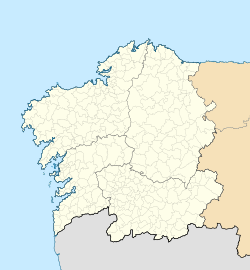Top Qs
Timeline
Chat
Perspective
Salvaterra de Miño
Municipality in Galicia, Spain From Wikipedia, the free encyclopedia
Remove ads
Salvaterra de Miño[a] is a town and municipality in Galicia, Spain. It is situated on the northern bank of the Miño River, which serves as the natural border between Spain and Portugal. Directly across the river lies the Portuguese town of Monção, with which it forms the Monção–Salvaterra de Miño Eurocity.[1] It is also part of the Vigo metropolitan area.
This article needs additional citations for verification. (April 2024) |
Remove ads
Name
The town was simply known as Salvatierra until 1916, when the Spanish government renamed over 500 municipalities to prevent confusion caused by identical place names.[2][b] As part of this effort, the town became Salvatierra de Miño (lit. Salvatierra by the Miño).[3] In 1983, in accordance with the Law of Linguistic Normalisation, the government officially recognised the Galician spelling, Salvaterra de Miño, as the official name in both Galician and Spanish.[4]
Residents of Salvaterra are known as salvaterrenses.
Remove ads
History
Summarize
Perspective
On 24 May 991, Bermudo II donated the landholding of the valley of Salvatierra to the Archidiocese of Santiago de Compostela, a territory which he had inherited from his father Ordoño III. The area contained a number of small settlements, the largest of which was Lacitorium, later known as Lazoiro.[5] In 1228, the settlement was renamed Salua terram (Salvatierra) when it was granted a municipal charter by Alfonso IX.[6] The name change is believed to have been inspired by the monarch's tendency to adopt French-inspired place names, such as Bayonne (Baiona), Vienne (Viana do Bolo), and, in this case Sauveterre-de-Béarn.[7]
Between 1643 and 1659, Salvaterra was occupied by the Portuguese during the Restoration War. Diego García Sarmiento de Sotomayor, Count of Salvatierra, had entrusted his friend, the Portuguese Gregorio Lopes de Puja, with command of the castle while he fought in Extremadura. However, Puja betrayed him by handing it over to João Rodrigo de Vasconcelos e Sousa, Count of Castelo Melhor. On 15 August 1643, Vasconcelos crossed the Miño and took possession of the fortress encountering some resistance from the locals.[8] Under Portuguese control, its defenses were significantly strengthened with the addition of new walls and bastions.
Remove ads
Geography
Location
Salvaterra is located in the southern part of the province of Pontevedra, at the confluence of the Tea and Miño river valleys, and by the natural limits of the Paradanta mountain range.
It borders the municipalities of Salceda de Caselas to the west, Mondariz and Ponteareas to the north, and As Neves to the east, while the Miño River forms its southern boundary.
Administration
Summarize
Perspective
Local government
The town council (Concello de Salvaterra de Miño) is responsible for the governance and administration of the municipality. It consists of 17 elected councillors, who make up the plenary (pleno), and the mayor (alcalde/alcaldesa) who is elected from among them. The council meets at the Casa do Concello in the Praza da Constitución.
The current mayor is Marta Valcarcel Gómez of the People's Party of Galicia, who was re-elected in 2023 with an absolute majority.[9]
Administrative subdivisions
The municipality of Salvaterra consists of 17 ecclesiastical parishes, known as parroquias, with Vilacoba and Uma as exclaves. The parishes outside the main town make up the majority of the municipality's 61 km2 land area.
Law enforcement
Salvaterra is served by the two national law enforcement agencies of Spain: the Civil Guard gendarmerie, with its barracks located on the outskirts of town, and the Policía Nacional station, situated near the old ferry crossing. Additionally, there is a smaller municipal police force, the Policía Local, based at the town hall.
Remove ads
Infrastructure
Summarize
Perspective
Crossings
Salvaterra is linked to Monçao by the João Verde/Amador Saavedra International Bridge which carries approximately 9,000 vehicles every day.[11] Before the construction of the bridge in 1995, the towns were served by a cable ferry which had been in operation for a decade.[12]
Public transport
Salvaterra and its surrounding parishes are connected to neighbouring towns by the Transporte Público de Galicia bus network, with the main route being the As Neves–Vigo bus service. A mixed-use school bus service also operates in the mornings, transporting both students and adults. Buses depart from the town's main bus stop on Rúa Raiña Dona Urraca.
Salvaterra train station is located in the town centre and is managed by Adif, with services operated by Renfe.[13] The station is part of the regional Monforte de Lemos–Redondela railway line.
Green spaces
A Canuda Park is a 49-acre (20 h) urban park located in the southern part of town along the riverbank. In addition to a large children's playground, it includes a range of facilities such as a calisthenics circuit, an amphitheatre, a road safety circuit and a small botanical garden. Salvaterra also has a number of riverside hiking trails that follow the tributaries feeding into the Miño.
Remove ads
See also
- Salvatierra, municipality of the same name in the Basque Country, Spain.
- List of municipalities of Moetrago
Notes
- Galician pronunciation: [salβaˈtɛra ðe ˈmiɲo]; Spanish: Salvatierra de Miño
- The neighbouring municipality of Salceda also changed its name to Salceda de Caselas
References
External links
Wikiwand - on
Seamless Wikipedia browsing. On steroids.
Remove ads










